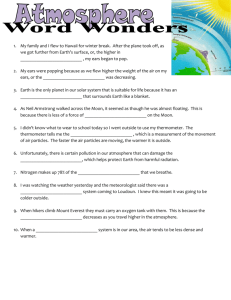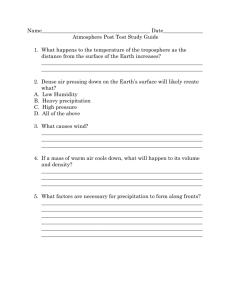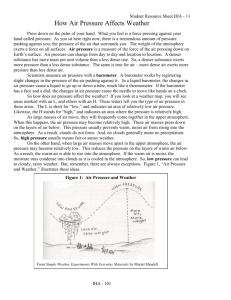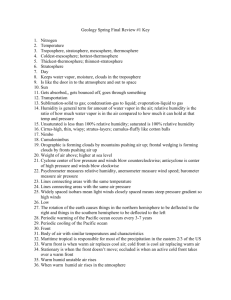Study Guide Answers Lesson 1 through 6 (page 22/23)How are
advertisement
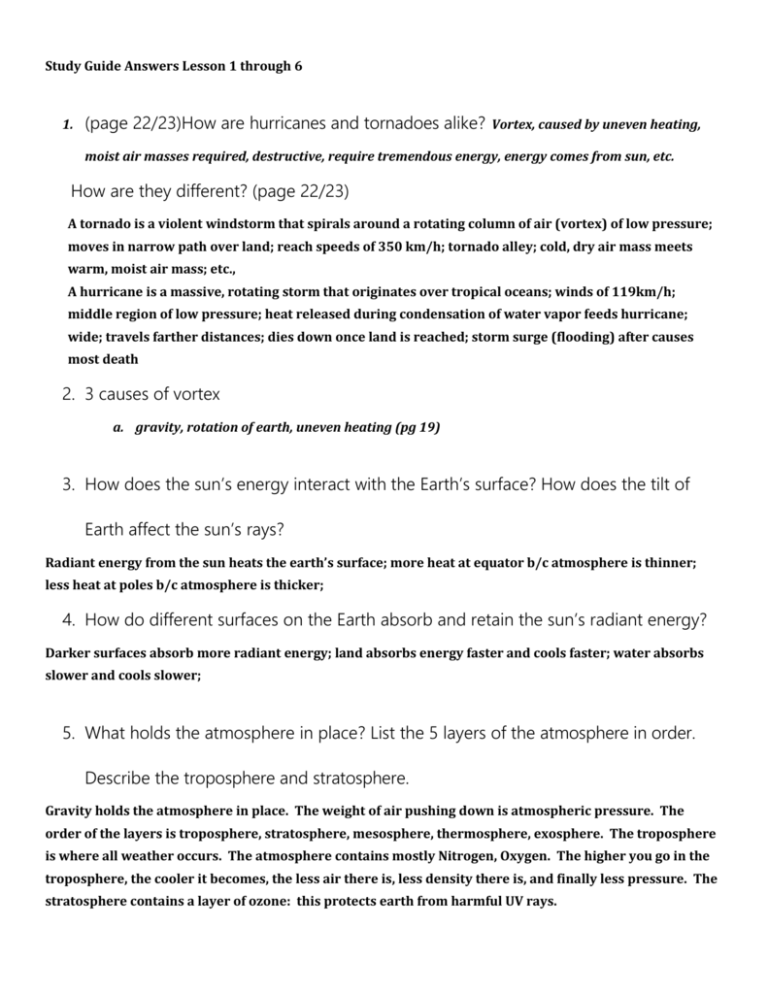
Study Guide Answers Lesson 1 through 6 1. (page 22/23)How are hurricanes and tornadoes alike? Vortex, caused by uneven heating, moist air masses required, destructive, require tremendous energy, energy comes from sun, etc. How are they different? (page 22/23) A tornado is a violent windstorm that spirals around a rotating column of air (vortex) of low pressure; moves in narrow path over land; reach speeds of 350 km/h; tornado alley; cold, dry air mass meets warm, moist air mass; etc., A hurricane is a massive, rotating storm that originates over tropical oceans; winds of 119km/h; middle region of low pressure; heat released during condensation of water vapor feeds hurricane; wide; travels farther distances; dies down once land is reached; storm surge (flooding) after causes most death 2. 3 causes of vortex a. gravity, rotation of earth, uneven heating (pg 19) 3. How does the sun’s energy interact with the Earth’s surface? How does the tilt of Earth affect the sun’s rays? Radiant energy from the sun heats the earth’s surface; more heat at equator b/c atmosphere is thinner; less heat at poles b/c atmosphere is thicker; 4. How do different surfaces on the Earth absorb and retain the sun’s radiant energy? Darker surfaces absorb more radiant energy; land absorbs energy faster and cools faster; water absorbs slower and cools slower; 5. What holds the atmosphere in place? List the 5 layers of the atmosphere in order. Describe the troposphere and stratosphere. Gravity holds the atmosphere in place. The weight of air pushing down is atmospheric pressure. The order of the layers is troposphere, stratosphere, mesosphere, thermosphere, exosphere. The troposphere is where all weather occurs. The atmosphere contains mostly Nitrogen, Oxygen. The higher you go in the troposphere, the cooler it becomes, the less air there is, less density there is, and finally less pressure. The stratosphere contains a layer of ozone: this protects earth from harmful UV rays. 6. Explain what causes the Earth’s seasons? When northern hemisphere is tilted toward earth, we receive more radiant energy and experience summer; when northern hemisphere is tilted away from sun, we receive less radiant energy and experience winter. 7. Think about the investigation in Lesson 3 when you heated soil and water. **How did you set up your investigation to make it a fair test? Controlled all variables **Which heated faster: soil or water? (or, rather, should have) Soil **Which held its heat longer: soil or water? (or, rather, should have) Water 8. Study the illustration of Tornado Alley on page 65. **What states make up Tornado Alley? Texas, Oklahoma, Kansas, Missouri **What cause tornadoes to form in Tornado Alley? Warm moist air masses from Gulf of Mexico with cool, dry air masses from Canada. 9. (pages 59-62) Describe/draw a convection current? A convection current is the movement of warm air particles upward and cool air downward due to the uneven heating of the earth’s surface. Heat is transferred to air particles (from warm land or water) above it by conduction. The air particles expand and become less dense. This air mass then rises upward. Cool, more contracted, denser air moves in to fill the space voided by the warm air rising. This movement of air masses is heat transfer by convection. 10. (page 63)Describe the 4 types of fronts – cold, warm, stationary, occluded. What weather do they produce? 11. Take another look at the illustration of a sea breeze and a land breeze on page 59. How and when does each form? Use science terms to explain. Sea Breeze: Land absorbs radiant energy from the sun faster during the day; this heat is transferred to air particles above it by conduction; the air particles expand, become less dense and start to rise. Cool air rushes in to take its place. Oceans absorb radiant energy slower during the day; heat is transferred from the warmer A.P. to the cooler ocean particles; this causes the APs to contract, become more dense, and sink. The opposite happens for a Land Breeze. **Remember, winds are named for the direction they come from…*** 12. Look at the illustration of the water cycle on page 72. Be able to describe the water cycle and how clouds form. The water cycle is the movement and exchange of water between earth’s surface , atmosphere, and oceans. Start wit the ocean water evaporates, rises into the atmosphere where it is cooler and there is lower air pressure. Both of these condition allow water vapor to condense on dust particles in the atmosphere and form clouds. When the condensation becomes heavy enough, the water droplets precipitate out as rain, sleet, snow, hail, or snow…. 13. Explain the suns role and energy transfer in the water cycle. The sun is the only source of energy for the water cycle. Radiant energy transfers heat energy to the ocean’s water particles. When water has enough energy, they evaporate from the surface of the ocean, and become water vapor/gas. As it rises, the water vapor releases heat energy and cools. The released heat absorbed by more water particles which make them rise even higher… 14. Look at the weather maps on page 70 a. Where is the pressure high? More air particles create a more dense atmosphere that creates a high pressure area. What is the weather like there? Sunny, clear skies b. Where is the pressure low? Less air particles create a less dense atmosphere thatcreates a low pressure area. What is the weather like there? Cloudy, chance of rain. c. Find a front. Where is it? What is the weather like there? d. In what direction is the weather moving across the United States? How can this help meteorologists? Weather tends to move west to east – this can help with forecasting. 15. Describe how clouds form; Clouds form when warm air rises (air includes water vapor); both temperature and pressure decrease as the water vapor rises and expands. Condensation can take place if there are dust or pollution particles for the water vapor to condense on. This condensed water is a cloud. Ingredients for a cloud: warm moist air, evaporation, condensation, dust, cool air, low pressure how high and low pressure affects the weather: answered early which direction between pressure does air flow Air flows from high pressure to low pressure 16. What type of clouds indicate high pressure and low pressure High wispy clouds indicate high pressure; low, dense clouds indicate low pressure Controlled experiment/inquiry goals: 17. Identify MV, RV, CV in experiment 18. ID energy transfers and transformations in experiments with heat 19. Write a 4-sentence paragraph analyzing data.

